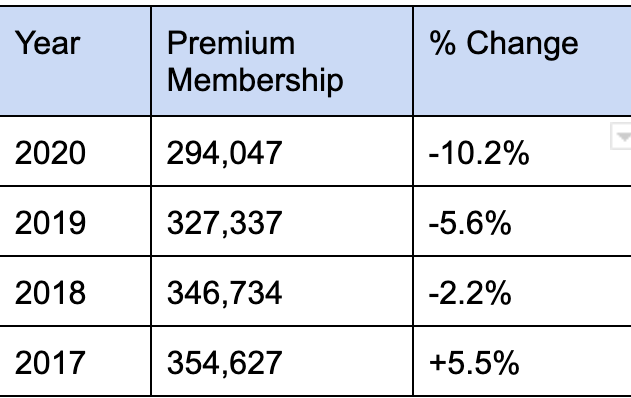A Rising Tide Raises All Boats
The above phrase was perhaps written by, certainly popularized by John F. Kennedy. President Kennedy was leveraging the phrase to combat criticism of an infrastructure project.
The number of youth athletes participating in American swimming is dwindling.
For three consecutive years, from 2018-2020 USA Swimming saw a decrease in premium memberships. That was also the case between 2014-2016. These two stretches are the only time in the reported numbers (dating back to 1986) that there have been 3 consecutive years of membership decline. Compounding that, the +5.5% post Olympic year “membership bump” was the smallest such bump in 20 years.
USA Swimming Membership Demographic Report
USA Swimming Membership Demographic Report
This pre-pandemic trend has only been accelerated by the last two years. Now, in a world with covid (whatever that means to you), families are reevaluating how they spend their time. Fear of infection combined with this disposition are likely to drive numbers even lower. Please excuse my focus on the American swimming market; this is the population I know best and frankly, the numbers are well reported and readily available.
With that as our backdrop, we must be honest that there is not much swimming available for the athlete who wants to do something between “not swimming at all” and “going all in”. When the only option is six sessions minimum and meets that span five hours on both Saturday and Sunday, increasingly families are put to tough decisions on how to parcel their days. We have all encounter the common coaching scorn for athletes who don’t make all the sessions, or have conflicting activities. Rather than scorning those athletes, perhaps we can use the opportunity to look inwards.
Please don’t confuse this with a critique of elite performance development. I’m a lifelong club coach and swimmer, and have seen the benefits first hand; benefits for the elite and others who strive to be so (please allow me to save that for another day). What I do mean to say, however, is that we often try to squeeze all the potential swimmers into a fairly tight box.
I don’t mean to be coy or to pretend there aren’t other relevant forces at work. To name a singular example, kids spend more time online. Regardless of the reasons for the dip, we are well served to recognize them, analyze them and face them with the seriousness they deserve.
We should not see burnout as a necessary feature of the sport.
Whether our goal is to instigate more involvement in the sport we love, so more can reap its benefits, to improve our retention numbers, or to imbue the benefits of elite performance, we would be wise to evaluate our program options. What is being offered? What are the overt aims of the programming? More to our purpose, who are we leaving behind: the offseason high school/ middle school swimmer, the triathlete, the kids who just needs to move their bodies?
Broadly speaking, the more athletes who are involved in swimming, the more likely your club and our sport are to enjoy sustainable growth long term. As stated earlier, “A Rising Tide Raises ALL Boats”.
When you design your programs for the next swim season, I hope you will remember the above quote.
Thanks for reading.
Jeff




